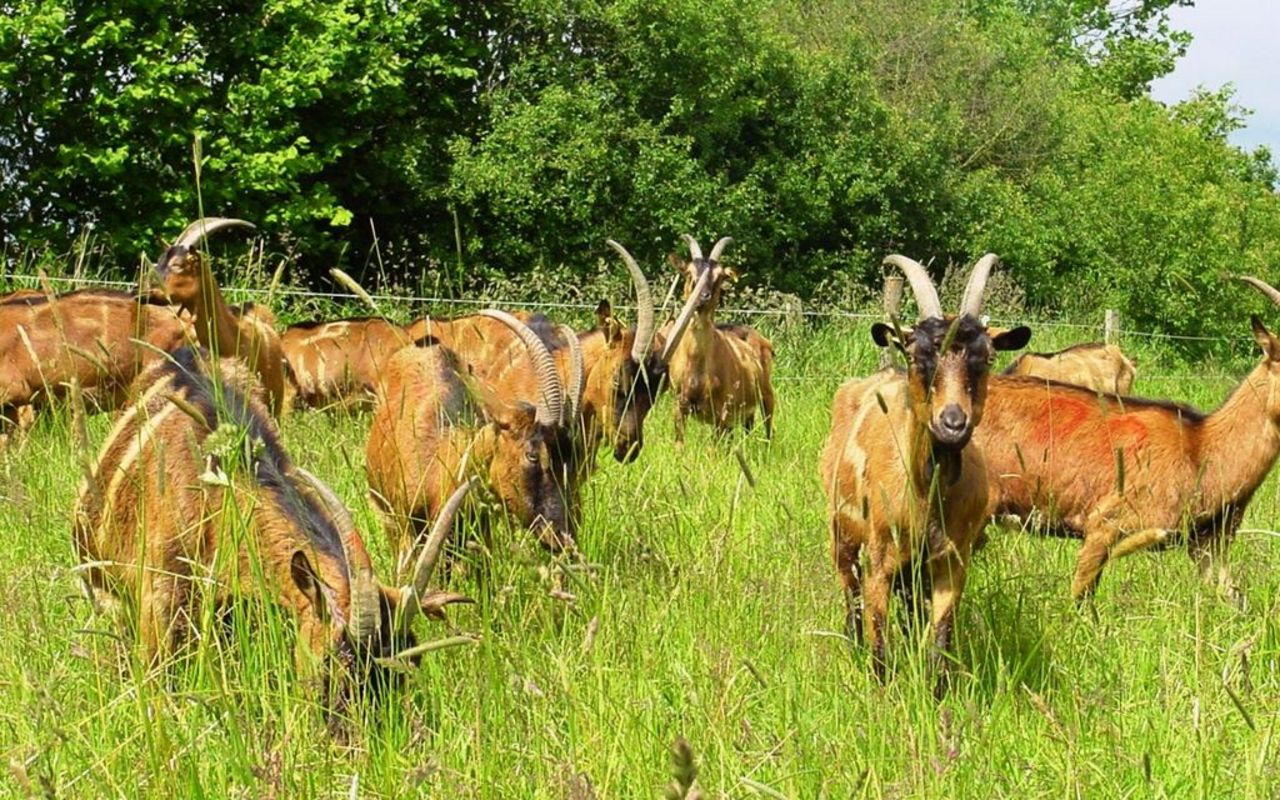Project
Feed less Food - concentrate reduced dairy goat keeping

"Feed less Food" - Concentrate reduced goat milk production
Feed less food is not only an issue of improving animal welfare but also an issue of reducing potential food for human for herbivore (cattle, sheep, goats) feeding. With the example of high performance dairy goats of the experimental station of the Institute (organic production) the question has be answered, how much the concentrate feeding can be reduced without problems in animal welfare (body weight) and how much milk can be produced.
Background and Objective
One of the reasons of the world hunger problem is the feeding of concentrates in animal husbandry. Particularly ruminates do not need concentrates. But in todays cow milk production between 250 and 500 g concentrates is used to produce on kilogramm of milk (different intensities). Goat milk production is even worse: 400 - 700 g concentrates are used to produce one kg of milk. The high performance breeds need high rations of concentrates, not only for milk yield but also for health and welfare.
In Organic farming the level of concentrates is already reduced (max. 50% of daily feeding ration), but still too high.
In a 6 years on-station experiment with dairy goats has been elaborated, how much the concentrate feedstuff can be reduced without animal health and welfare. The milk production performance and the economic impact have been assessed.
Approach
In 2009, the 70 dairy goats have been splitted into two groups (comparable lactation years and milk yields). One herd has been defined as 10%-, the other 40% concentrate group. Both groups have been kept together. They had the same roughage (hay and pasture ad libitum, with 50% remainings: to allow selection for high nutrient content. The remainings have been used for other groups or later in the year - low/no lactation periods). The concentrate was fed individual for each goat in the milking barn.
The seasonal feed rations have been in respect to the lactation status:
- In the last month of gastation: all goats became 500 g concentrate per day and ad libitum hay.
- In the first 2 months of lactation till starting grazing season (May) the 10% group got 500 g and the 40% group 1000 g per day concentrate as well as ad lib hay.
- On pasture the 10% group received zero concentrate, the 40% group 500 g per day, ad lib gras while grazing and in the night ad lib hay in the barn.
- In the breeding season (6 weeks in August-September) the 10% group received 250 g and the 40% group 500 g per day. The breeding groups have been kept seperated.
- After breeding season, the groups have been merged again and the 10% groups received zero and the 40% group 500 g per day till end of October.
- The grazing period ends in November. The goats have been dried. Both groups have not received concentrates till last month before next lambing (mid January to end February).
Measurements:
- The goats have been weighted every month
- The milk yields and the milk contrents have been tested monthly.
- Ethological studies have been made.
Results
- In organic farming is already used less concentrate compared to conventional milk production. (max. 50% in the daily rations). The concentrate share is still high, between 270 and 350 kg concentrates are fed per goat and year in organic farming.
- In organic dairy goat farming are usually 600 - 800 kg milk produced (240-days yield) respectively 650 - 900 in the whole lactation (270 - 290 days). Between 400 and 700 g concentrate per kg of milk is fed.
- Without losses in body weight, the concentrate can be reduced to 10% of the annual ration (70 - 90 kg).
- The milk yield of the 10% group was 20 to 25 % lower compared to the 40% group: 500-650 kg compared to 650-850 kg milk per lactation (270-290 days).
- Goats select roughage with higher value if they are restricted in concentrate feedstaff and get the chance to select. The roughage quality can reach the quality of concentrates.
- The concentrate and the roughage should be fed in relation to the needs of the dairy goats. Best rations (high quality of roughage and high amount of concentrate) should be fed in the high laction period. Not so good roughage and less concentrate should be fed at the end of the lactation or early dry period.
- Remaining roughage (pasture and indoor) can be fed in low production seasons or to young stock/other livestock.
- The amount of concentrate can be reduced to 50 - 100 g per kg of milk.
- With high concentrate prices makes it sense to reduce the amount of concentrates.
- The milk composition does not change in fat and protein content but in CLAs and Omega-3 fat acids with reduced concentrate feeding.
Thünen-Contact

Prof. Dr. agr. habil. Gerold Rahmann
Involved Thünen-Partners
Involved external Thünen-Partners
- Universität für Bodenkultur (BOKU)
(Wien, Österreich)
Publications
- 0
Volkmann A, Rahmann G, Knaus W (2014) Fatty acid composition of goat milk produced under different feeding regimens and the impact on Goat Cheese. Thünen Rep 20, Vol. 2:551-554
- 1
Bender S, Ude G, Rahmann G, Weißmann F, Aulrich K, Georg H (2014) Fatty acid composition of organic goat kid meat from dairy goat and crossbred meat goat kids. Thünen Rep 20, Vol. 2:523-526
- 2
Sporkmann KH, Bender S, Ude G, Georg H, Rahmann G (2012) "Feed less Food" : low input strategy results in better milk quality in organic dairy goats. Landbauforsch SH 362:426-429
- 3
Aschenbach F, Rahmann G (2011) Bedeutung der Raufutterselektionsfähigkeit von Ziegen für ihre Ernährung. Landbauforsch SH 346:91-98
- 4
Aschenbach F, Rahmann G (2011) Body Condition Scoring bei Milchziegen. Landbauforsch SH 346:111-118
- 5
Rübeling S, Möller D, Rahmann G (2011) Sozioökonomische Analyse des Betriebsaufbaus von Milchschaf- und Milchziegenbetrieben. Landbauforsch SH 354:85-98
- 6
Rahmann G, Oppermann R (2010) "Feed less Food" als eine Möglichkeit, die zunehmende Weltbevölkerung zu ernähren. Landbauforsch SH 341:75-84
- 7
Rahmann G (2008) Keine Trockenschnitzel mehr für die Ziege. Bio Austria(1):10-11
- 8
Rahmann G (2008) Ziegen richtig füttern. In: Bio Austria Bauerntage 2008 : 28. - 31. Jänner 2008, Bildungshaus Schloss Puchberg, Wels ; Zusammenfassung der Tagungsbeiträge. Linz: Bio Austria, pp 71-74
- 9
Rahmann G, Hauschild B (2007) Jahr für Jahr mehr Milch : eine Milchziegenherde will sorgfältig aufgebaut werden und erreicht ihre Spitzenleistung erst nach einigen Jahren ; wie sich das darstellen kann, zeigen Ergebnisse aus Trenthorst. Bio Land(7):18-19

![[Translate to English:] [Translate to English:]](/media/_processed_/8/e/csm_Bildschirmfoto_2021-03-03_bearb_fc48ac88bf.jpeg)
![[Translate to English:] [Translate to English:]](/media/_processed_/8/e/csm_Bildschirmfoto_2021-03-03_bearb_ba3ec0e9d7.jpeg)
![[Translate to English:] Logo des Bundesministerium für Ernährung und Landwirtschaft](/media/allgemein/logos/BMEL_Logo.svg)